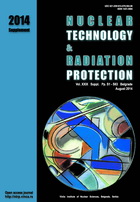
MCNPX SIMULATIONS OF THE RESPONSE OF THE EXTENDED-RANGE REM METER WENDI-2

Vol.
XXIX, Suppl., Pp. S1-S63
August 2014
UDC 621.039+614.876:504.06
ISSN 1451-3994
Pages: S25-S30
Authors: Valerie De Smet, Isabelle Gerardy, Frederic Stichelbaut, and Silvia Tolo
Abstract
Proton therapy uses proton beams with energies typically between 50 and 230 MeV to treat cancerous tumors very efficiently, while protecting as much as possible surrounding healthy tissues from radiation damage. Protons interacting with matter inevitably induce secondary radiation from which all people inside the proton therapy center have to be protected. The ambient dose equivalent H*(10) in such a facility is mainly due to neutrons, which can have energies up to 230 MeV. Although various dose monitoring systems sensitive to high energy neutrons have already been developed, the response function of these detectors is often insufficiently characterized, and so are the calibration factors appropriate for the specific neutron spectra encountered inside a proton therapy facility. In this work, the Monte Carlo code MCNPX 2.5.0 has been used to study the response function of the extended-range rem-meter WENDI-2 from thermal energies up to 5 GeV. A good match has been obtained with equivalent simulation results found in literature. As a first step towards the characterization of the WENDI-2 response in continuous neutron fields, MCNPX simulations have also been carried out for the case-study of a bunker around an 18 MeV H– cyclotron, which involves neutron fields from thermal energies up to 18 MeV.
Key words: neutron dosimetry, MCNPX simulation, response function, rem-meter, WENDI-2
FULL PAPER IN PDF FORMAT (1,00 MB)